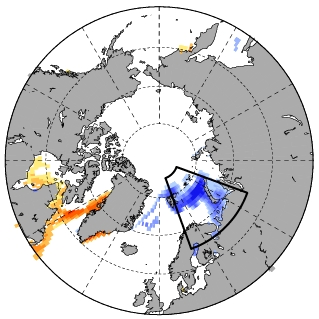- HOME
- NEWS
- RCAST Report
- On Thin Ice: Link Between Arctic Sea-Ice Loss and Eurasian Cooling Confirmed
On Thin Ice: Link Between Arctic Sea-Ice Loss and Eurasian Cooling Confirmed
- Research News
January 22, 2019

-
Researchers at The University of Tokyo have confirmed the link between the loss of Arctic sea ice and a cooler climate in Eurasia, explaining why discrepant findings on this link were made in previous climate change studies
Research findings overwhelmingly support the reality of climate change and that human activities are its major cause. However, much remains unclear about how different Earth systems, such as the atmosphere, the sea, the sea ice, and the land, as well as greenhouse gases, interact in the context of climate change.
One particular conundrum within climate change research is the finding of a continual drop in winter temperature in central Eurasia in recent decades, conflicting with the general prospect of warming globally, including the pronounced warming in the Arctic. Some studies have suggested that the loss of sea ice in the Arctic has contributed to the colder climate in this region, but others have contradicted this.
In a new study reported in the journal Nature Climate Change, a research team at The University of Tokyo has shed more light on this issue by showing that 44% of wintertime cooling that has recently occurred in central Eurasia is due to the loss of sea ice in the Arctic, particularly in the Barents Sea northeast of Scandinavia and the Kara Sea north of central Russia.
The team used a combination of data from actual observations and seven different numerical models of the circulation in the atmosphere to show the link between sea-ice loss and the severely cold winters that have repeatedly struck central Eurasia in recent years, and also to explain the potential shortcomings in atmospheric models that could have led to discrepant findings on this issue among various research groups.
“Our use of observational data and model experiments based on historical data on sea-surface temperature and sea-ice concentration provided unique insights into this feature of climate change,” says lead author Masato Mori at The University of Tokyo’s Research Center for Advanced Science and Technology. “We found that all models had underestimated the forced surface temperature response to sea-ice loss in the Arctic, and correcting this reconciled discrepant findings among studies can lead to a more accurate estimation of the atmospheric link between central Eurasia and the Barents–Kara Seas.”
The underestimation of response in the model means that the influence of sea-ice loss is easily masked by other factors unless the analysis is conducted with special care, which is a potential cause of discrepant conclusions. However, the mechanisms that bring this underestimation are just beginning to be understood.
“There is a possibility that Arctic sea ice can be one of the key sources of better seasonal prediction and future climate projection in Eurasia. Therefore, there is an urgent need to clarify the cause of model error,” Masato Mori says. “The better future projection can also inform policy decisions about how best to mitigate the change, and where best to focus resources in our efforts to minimize the effects of climate change.”
The article “A reconciled estimate of the influence of Arctic sea-ice loss on recent Eurasian cooling” is published in Nature Climate Change at doi: 10.1038/s41558-018-0379-3 .
###
Journal Article
Masato Mori*, Yu Kosaka, Masahiro Watanabe, Hisashi Nakamura & Masahide Kimoto
A reconciled estimate of the influence of Arctic sea-ice loss on recent Eurasian cooling, Nature Climate Change.
DOI:10.1038/s41558-018-0379-3
Research Contact
Masato Mori, Research Associate
Climate Science Research
URL:https://www.atmos.rcast.u-tokyo.ac.jp/nakamura_lab/en/index.html

